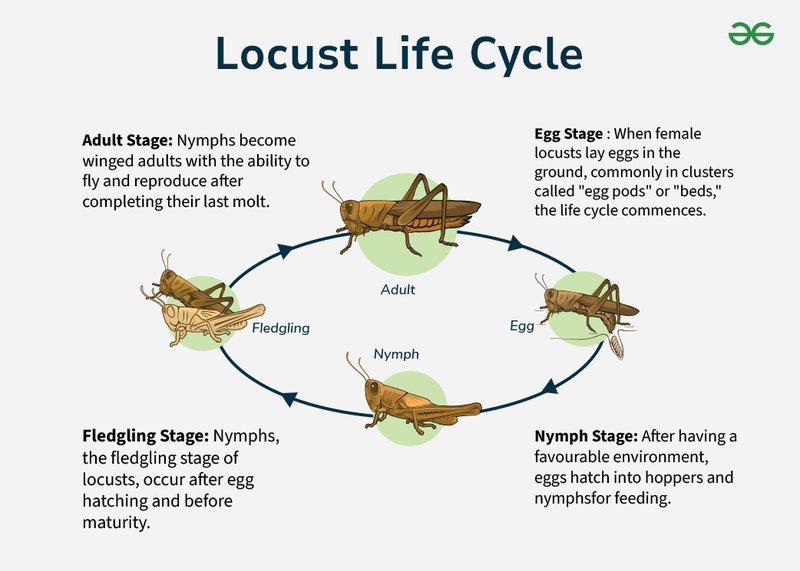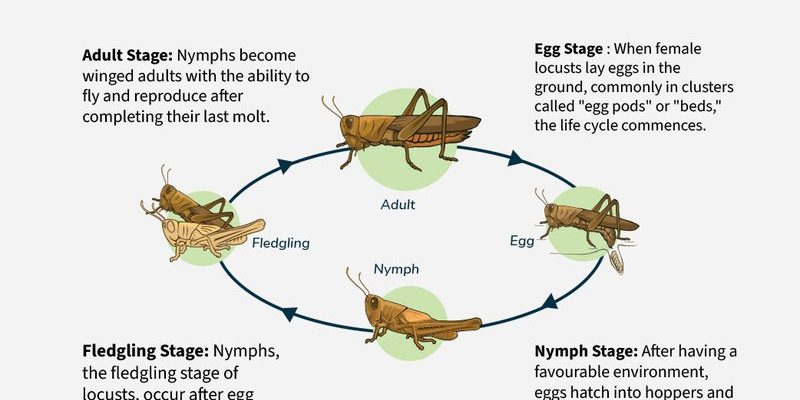
Locusts, particularly the ones from the Acrididae family, are known for their incredible adaptability and multi-stage lifecycle. They’re often portrayed as pests, especially when they form swarms, but understanding their lifecycle can give us insight into their behavior and ecological role. So, let’s dive into the stages of a locust’s life, from that little egg hidden in the soil to the soaring adult!
Stage 1: The Egg
The journey of a locust begins as a tiny, almost invisible egg. Locusts lay their eggs in the soil, often in clusters. This can be likened to a mother bird finding the perfect place to nest. The eggs are typically elongated and about 2-3 mm long. They usually take about 1 to 2 weeks to hatch, depending on the environmental conditions.
When the time comes for the eggs to hatch, locusts don’t simply break out like some dramatic movie characters. Instead, they undergo a process called molting. The young locusts, or nymphs, will emerge from the soil and be ready to take on the world. It’s this period that can be quite tricky, as they face many dangers, from predators to harsh weather conditions.
The number of eggs laid can vary widely, with a female locust capable of laying hundreds of eggs in one go! Imagine a single egg turning into a bustling swarm of young locusts. That’s a lot of potential for growth, right?
Stage 2: The Nymphs
Once the eggs hatch, we enter the nymph stage. Nymphs look quite a bit like adult locusts, but they’re smaller and lack wings. They’re often referred to as hoppers because they can jump around as they grow. Metaphorically, they’re like teenagers trying to find their place in the world.
Nymphs undergo several molts—usually between five to six times—before they reach adulthood. Each time they molt, they shed their skins, which can look a little gruesome but is completely normal. During this time, they’re super hungry! They’ll munch on anything from grasses to crops, which is part of why they are sometimes seen as pests.
You might wonder what triggers their transformation from nymph to adult. It mostly depends on environmental factors like temperature and food availability. If the conditions are right, these young locusts can flourish and grow rapidly.
Stage 3: The Swarm Behavior
Here’s where it gets interesting! When conditions are perfect—think lots of food and ideal temperatures—locusts can undergo a phenomenon known as gregarization. This is just a fancy way of saying they start changing their behavior and physiology when they gather in large numbers. It’s like a social gathering, but instead of a party, it could lead to a massive swarm!
During this stage, their coloration changes, and they even become more aggressive and social. They develop a sort of pack mentality, which often leads to swarming behavior. Imagine a group of friends hyping each other up to go out. As they come together, they can travel long distances, consuming everything in their path.
Swarming can create a spectacular sight, but it also poses a threat to agriculture, as the locusts can devastate crops in just a matter of days. So while the idea of large swarms may sound intriguing, it’s essential to consider the impact they have on the environment and farming.
Stage 4: The Adult Locust
Finally, after several molts and a lot of growth, our locusts become adults. Adult locusts are quite impressive; they have wings and can travel far and wide. This stage can last anywhere from a few weeks to several months, depending on their species and environmental conditions.
Adult locusts can reproduce and start the lifecycle all over again. Just think about it: one locust can lead to hundreds more, completing a full circle in nature’s grand design. Their ability to fly allows them to search for food and find mates. And here’s the thing—many species have a short lifespan, which makes their growth and reproduction even more critical to the continuation of their species.
Interestingly, adult locusts can also change their color and behavior based on their surroundings. When in a swarm, they might be more vibrant, while solitary ones can take on a more muted appearance. It’s like they’re adapting to fit the mood of the crowd!
The Ecological Impact of Locusts
You might be thinking, “What’s the big deal about locusts besides their transformation?” That’s a great question! They play a significant role in the ecosystem. As herbivores, they help control plant growth, and when they form swarms, they can impact agriculture significantly.
On one hand, their feeding can stimulate new growth in some plants, creating a cycle of renewal. On the flip side, they can cause massive damage to crops, leading to food shortages and economic hardships in farming communities.
Locusts also serve as food for various predators, such as birds, reptiles, and mammals. This makes them a crucial part of the food web. It’s all about balance, and though they can be problematic, they serve their purpose in the ecosystem.
So, there you have it—the lifecycle of a locust from egg to adult is a journey filled with transformation, social dynamics, and ecological significance. From laying eggs in the soil to becoming adult swarming machines, locusts remind us of the incredible cycles of life in nature.
Understanding this lifecycle isn’t just for science enthusiasts; it’s important for anyone who eats food or cares about the environment. The next time you hear about locusts, remember their journey, and you might just see them in a new light—one that appreciates their role in the grand tapestry of life.

